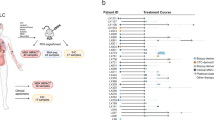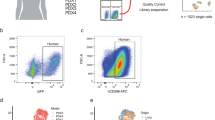Abstract
Metastasis of squamous cell carcinoma of the head and neck (SCCHN) is a significant health-care problem worldwide. The 5-year survival rate is less than 50% for patients with lymph node metastases. Understanding the molecular basis of SCCHN metastasis would facilitate the development of new therapeutic approaches to the disease. To identify proteins that mediate SCCHN metastasis, we established a SCCHN xenograft mouse model and performed in vivo selection from a SCCHN cell line using the model. In the fourth round of in vivo selection, significant incidences of metastases in lymph nodes (7/10) and lungs (6/10) were achieved from a derived SCCHN cell line as compared with its parental cells, 1/5 in lymph nodes and 0/5 in lungs. Metastatic cell lines from lymph node metastases and parental cell lines from non-metastatic xenograft tumors were subjected to DNA microarray analysis using an Affymetrix gene chip HG-U133A, followed by data mining studies. The identified metastasis-related genes were further evaluated for their encoding protein products and the metastatic cells were examined by biological analyses. DNA microarray analysis highlighted molecular features of the metastatic SCCHN cells, including alteration of expression of cell–cell adhesion proteins, epithelial cell markers, apoptosis and cell cycle regulatory molecules. Further biological analyses of phenotypic alterations revealed that the metastatic cells gained epithelial-mesenchymal transition (EMT) features and were more resistant to anoikis, which are two of the important phenotypes for metastatic SCCHN.




Similar content being viewed by others
Abbreviations
- SCCHN:
-
Squamous cell carcinoma of head and neck
- EMT:
-
Epithelial-mesenchymal transition
- EGFR:
-
Epidermal growth factor receptor
- TGF-β:
-
Transforming growth factor-β
- E-cad:
-
E-cadherin
- Cav-1:
-
Caveolin-1
- MAPK:
-
Mitogen-activated protein kinase
- MMP:
-
Matrix metalloproteinase
- MT1-MMP:
-
Membrane type 1-MMP
- uPAR:
-
Urokinase-type plasminogen activator receptor
- PKC:
-
Protein kinase C
- COX-2:
-
Cyclooxygenase-2
- DMEM:
-
Dulbecco’s modified Eagle’s medium
- PBS:
-
Phosphate buffered saline
- PAGE:
-
Polyacrylamide gel electrophoresis
- 5-Aza-dC:
-
5-aza-2′-deoxycytidine
- ICF:
-
Immunocytofluorescence
- RFU:
-
Relative fluorescence unit
References
Parkin DM, Pisani P, Ferlay J (1999) Global cancer statistics. CA Cancer J Clin 49:33–64
Jemal A, Murray T, Ward E et al (2005) Cancer statistics, 2005. CA Cancer J Clin 55:10–30
Som PM (1992) Detection of metastasis in cervical lymph nodes: CT and MRI criteria and differential diagnosis. Am J Radiol 158:961–969
Cancer Facts & Figures 2005 (2005) Edit: American Cancer Society, p 17
Johnson JT, Barnes EL, Myers EN et al (1981) The extracapsular spread of tumors in cervical node metastasis. Arch Otolaryngol 107:725–729
Chambers AF, Groom AC, MacDonald IC (2002) Dissemination and growth of cancer cells in metastatic sites. Nat Rev Cancer 2:563–572
Fidler IJ (2003) The pathogenesis of cancer metastasis: the ‘seed and soil’ hypothesis revisited. Nat Rev Caner 3:1–6
Fidler IJ (2002) The organ microenvironment and cancer metastasis. Differentiation 70:498–505
Thiery JP (2003) Epithelial-mesenchymal transitions in development and pathologies. Curr Opin Cell Biol 15:740–746
Thompson EW, Newgreen DF, Tarin D (2005) Carcinoma invasion and metastasis: a role for epithelial-mesenchymal transition? Cancer Res 65:5991–5995; discussion 5995
Tarin D, Thompson EW, Newgreen DF (2005) The fallacy of epithelial mesenchymal transition in neoplasia. Cancer Res 65:5996–6000; discussion 6000–6001
Frisch SM, Francis H (1994) Disruption of epithelial cell–matrix interactions induces apoptosis. J Cell Biol 124:619–626
Frisch SM, Screaton RA (2001) Anoikis mechanisms. Curr Opin Cell Biol 13:555–562
Grossmann J (2002) Molecular mechanisms of “detachment-induced apoptosis–Anoikis”. Apoptosis 7:247–260
Zhang X, Liu Y, Gilcrease MZ et al (2002) A lymph node metastatic mouse model reveals alteration of metastasis-related gene expression in metastatic human oral cancer sublines selected from a poorly metastatic parental cell line. Cancer 95:1663–1672
Chen Z, Zhang K, Zhang X et al (2003) Comparison of gene expression between metastatic derivatives and their poorly metastatic parental cells implicates curial tumor-environment interaction in metastasis of head and neck squamous cell carcinoma. Clin Exp Met 20:335–342
Fiucci G, Ravid D, Reich R, Liscovitch M (2002) Caveolin-1 inhibits anchorage-independent growth, anoikis and invasiveness in MCF-7 human breast cancer cells. Oncogene 21:2365–2375
Fidler IJ, Kripke ML (1977) Metastasis results from preexisting variant cells within a malignant tumor. Science 197(4306):893–895
Heppner G, Yamashina K, Miller B, Miller F (1986) Tumor heterogeneity in metastasis. Prog Clin Biol Res 212:45–59
Ramaswamy S, Ross KN, Lander ES, Golub TR (2003) A molecular signature of metastasis in primary solid tumors. Nat Genet 33:49–54
Fidler IJ, Kripke ML (2003) Genomic analysis of primary tumors does not address the prevalence of metastatic cells in the population. Nat Genet 34:23; author reply 25
Zhang X, Hunt JL, Landsittel DP et al (2004) Correlation of protease-activated receptor-1 with differentiation markers in squamous cell carcinoma of the head and neck and its implication in lymph node metastasis. Clin Cancer Res 10:8451–8459
Wang J, Xi L, Hunt JL et al (2004) Expression pattern of chemokine receptors 6 (CCR6) and 7 (CCR7) in squamous cell carcinoma of the head and neck identifies a novel metastatic phenotype. Cancer Res 64:1861–1866
Chen Z, Sun W, Zhang X, Choe M, Shin DM (2005) Selection of metastasis-related genes from a lymph node metastasis mouse model of the head and neck cancer. Clin Exp Met 21:638
Jones J, Out H, Spentzos D et al (2005) Gene signature of progression and metastasis in renal cell cancer. Clin Cancer Res 11:5730–5739
Xi L, Lyons-Weiler J, Coello MC et al (2005) Prediction of lymph node metastasis by analysis of gene expression profiles in primary lung adenocarcinomas. Clin Cancer Res 11:4128–4235
Weiget B, Glas AM, Wessels LFA, Witteveen AT, Peterse JL (2003) Gene expression profiles of primary breast tumors maintained in distant metastases. Proc Natl Acad Sci USA 100:15901–15905
Paris PL, Weinberg V, Simko J (2005) Preliminary evaluation of prostate cancer metastatic risk biomarkers. Int J Biol Markers 20:141–145
Roepman P, Wessels LFA, Kettelarij N et al (2005) An expression profile for diagnosis of lymph node metastases from primary head and neck squamous cell carcinomas. Nat Genet 37:182–186
Chung CH, Parker JS, Karaca G et al (2004) Molecular classification of head and neck squamous cell carcinomas using patterns of gene expression. Cancer Cell 5:489–500
Eckhardt BL, Parker BS, van Laar RK et al (2005) Genomic analysis of a spontaneous model of breast cancer metastasis to bone reveals a role for the extracellular matrix. Mol Cancer Res 3:1–13
Kluger HM, Chelouche Lev D, Kluger Y et al (2005) Using a xenograft model of human breast cancer metastasis to find gene associated with clinically aggressive disease. Cancer Res 65:5578–5587
Huber MA, Kraut N, Beug H (2005) Molecular requirements for epithelial-mesenchymal transition during tumor progression. Curr Opin Cell Biol 17:548–558
Thiery JP (2002) Epithelial-mesenchymal transitions in tumor progression. Nat Rev Cancer 2:442–454
Bankfalvi A, KraBort M, Buchwalow LB, Vegh A, Feiszeghy E, Piffiko J (2002) Gains and losses of adhesion molecules (CD44, E-cadherin, and β-catenin) during oral carcinogenesis and tumor progression. J Pathol 198:343–351
Bankfalvi A, Krassort M, Vegh A, Felszeghy E, Piffko L (2002) Deranged expression of the E-cadherin/beta-catenin complex and the epidermal growth factor receptor in the clinical evolution and progression of oral squamous cell carcinomas. J Oral Pathol Med 31:450–457
Conacci-Sorrell M, Zhurinsky J, Ben-Ze’ev A (2002) The cadherin-catenin adhesion system in signaling and cancer. J Clin Invest 109:987–991
Zavadil J, Bottinger EP (2005) TGF-β and epithelial-to-mesenchychymal transitions. Oncogene 24:5764–5774
Bachman KE, Park BH (2005) Duel nature of TGF-β signaling: tumor suppressor vs. tumor promoter. Curr Opin Oncol 17:49–54
Summy JM, Gallick GE (2003) Src family kinase in tumor progression and metastasis. Cancer Met Rev 22:337–358
Avizienyte E, Brunton VG, Fincham VJ, Frame MC (2005) The SRC-induced mesenchymal state in late-stage colon cancer cells. Cell Tissues Organs 179:73–80
Playford MP, Schaller MD (2004) The interplay between Src and integrins in normal and tumor biology. Oncogene 23:7928–7946
Ishizawar R, Parsons SJ (2004) C-Src and cooperating partners in human cancer. Cancer Cell 6:209–214
Engelberg D (2004) Stress-activated protein kinases-tumor suppressors or tumor initiators? Semi Cancer Biol 14:271–282
Bhowmick NA, Zent R, Ghiass M, McDonnell M, Moses H (2001) Integrin β1 signaling is necessary for transforming growth factor-β activation of p38MAPK and epithelial plasticity. J Biol Chem 276:46707–46713
Shin I, Kim S, Song H, Kim H-RC, Moon A (2005) H-Ras-specific activation of Rac-MKK3/6-p38 Pathway. J Biol Chem 280:14675–14683
Laferriere J, Houle F, Huot J (2002) Regulation of the metastatic process by E-selectin and stress-activated protein kinase-2/p38. Ann NY Acad Sci 973:562–572
Lin M, DiVito MM, Merajver SD, Boyanapalli M, van Golen KL (2005) Regulation of pancreatic cancer cell migration and invasion by RhoC GTPase and caveolin-1. Mol Cancer 4:21
Okamoto T, Schlegel A, Scherer PE, Lisanti MP (1998) Caveolins, a family of scaffolding proteins for organizing “preassembled signaling complexes” at the plasma membrane. J Biol Chem 273:5419–5422
Liu P, Rudick M, Anderson RG (2002) Multiple functions of caveolin-1. J Biol Chem 277:41295–41298
Chambers AF, Groom AC, MacDonald IC (2002) Dissemination and growth of cancer cells in metastatic sites. Nat Rev Cancer 2:563–572
Luzzi KJ, MacDonald IC, Schmidt EE et al (1998) Dormancy of solitary cells after successful extravasation and limited survival of early micrometastases. Am J Pathol 153:865–873
Wong CW, Lee A, Shientag L et al (2001) Apoptosis: an early event in metastatic inefficiency. Cancer Res 61:333–338
Kramer RH, Shen X, Zhou H (2005) Tumor cell invasion and survival in head and neck cancer. Cancer Met Rev 24:35–45
Yoon Y, Liang Z, Kang S (2005) CXCR4 antagonist blocks both primary tumor and metastasis in head and neck cancer animal models. Proceedings: AACR 46:Abstract 2327
Moroy T, Geisen C (2004) Cyclin E. Int J Biochem Cell Biol 36:1424–1439
Acknowledgement
This study is supported by an R21 grant from the US National Institutes of Health to Z (G) Chen.
Author information
Authors and Affiliations
Corresponding author
Rights and permissions
About this article
Cite this article
Zhang, X., Su, L., Pirani, A.A. et al. Understanding metastatic SCCHN cells from unique genotypes to phenotypes with the aid of an animal model and DNA microarray analysis. Clin Exp Metastasis 23, 209–222 (2006). https://doi.org/10.1007/s10585-006-9031-0
Received:
Accepted:
Published:
Issue Date:
DOI: https://doi.org/10.1007/s10585-006-9031-0




